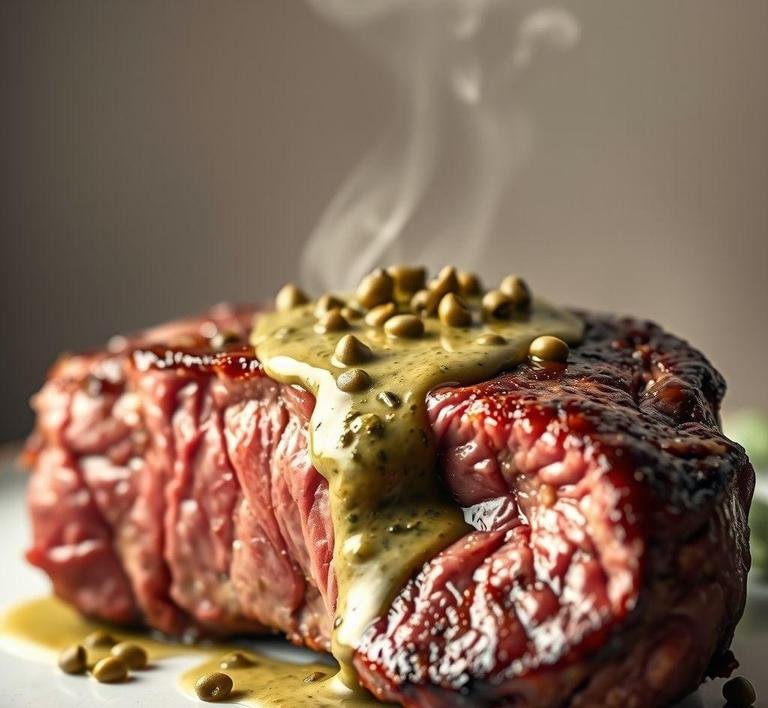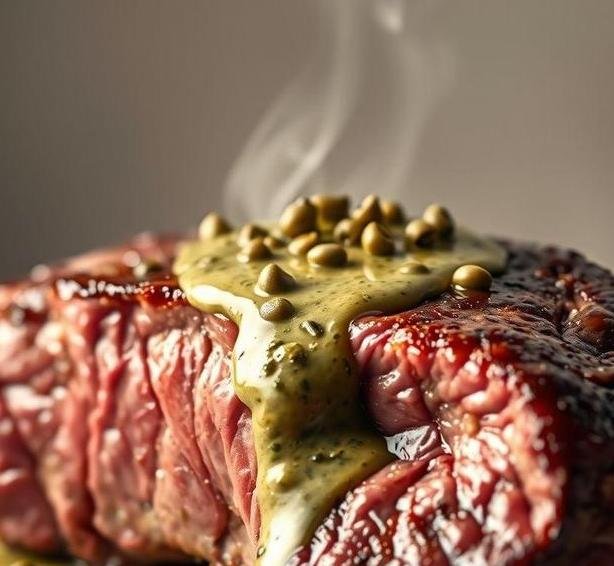Mary Berry’s Rib Eye Steak with Green Peppercorn Sauce is a classic, indulgent dish that combines the richness of a perfectly cooked rib-eye steak with the bold, aromatic flavor of a creamy green peppercorn sauce. The rib-eye steak, known for its tenderness and marbled fat that melts during cooking, becomes even more luxurious when paired with the robust flavors of the sauce.
The green peppercorn sauce is made using green peppercorns, which have a slightly milder, fresher flavor than black peppercorns. When blended into a creamy sauce with ingredients like butter, cream, and stock, the result is a velvety, aromatic sauce that complements the richness of the steak. The peppercorns offer a subtle heat and a pop of freshness, balancing the steak’s natural fattiness. This dish is ideal for a special occasion or for a satisfying, restaurant-quality meal made right at home.
The combination of a juicy steak with this indulgent sauce delivers a satisfying mouthful every time, making this dish a favorite among those who appreciate both fine dining and easy-to-follow recipes.
Mary Berry’s Rib Eye Steak With Green Peppercorn Sauce Recipe
Ingredients Needed

For Mary Berry’s Rib Eye Steak with Green Peppercorn Sauce, the ingredients are simple yet powerful. Here’s what you’ll need:
For The Steak
- 2 Rib Eye Steaks (about 8 oz or 225g each) – A good quality cut is essential for this dish. Rib-eye steaks are known for their tenderness, juicy marbling, and rich flavor, making them the ideal choice for this recipe.
- Salt – To season the steaks and bring out their natural flavors.
- Black Pepper – Freshly ground, for seasoning the steaks before cooking.
- Butter – A couple of tablespoons for cooking the steaks, contributing to the flavor and achieving that golden-brown sear.
For The Green Peppercorn Sauce
- 1 tbsp Butter – Adds richness to the sauce base.
- 2 tbsp Green Peppercorns (in brine, drained) – The hero ingredient of the sauce, bringing the fresh and mildly spicy flavor to the dish.
- 2 tbsp Brandy or Cognac – For deglazing the pan and enhancing the sauce with a touch of warmth and depth.
- 200 ml Double Cream – Creates the rich, velvety consistency of the sauce.
- 150 ml Beef Stock – Adds a savory base to the sauce, making it savory and balanced.
- 1 tbsp Dijon Mustard – Gives the sauce a slight tang and depth of flavor.
- Salt and Pepper – To season the sauce according to taste.
Equipment Needed
To make Mary Berry’s Rib Eye Steak with Green Peppercorn Sauce, you’ll need the following equipment to ensure perfect results:
- Heavy-Based Frying Pan or Skillet – A wide, heavy-bottomed frying pan is ideal for cooking the rib-eye steaks. The heavy base helps retain heat, ensuring the steak cooks evenly and develops a beautiful sear.
- Tongs – For flipping the steak without piercing the meat, ensuring all those flavorful juices remain inside.
- Small Saucepan – For preparing the green peppercorn sauce. A small, non-stick saucepan works best for the delicate process of reducing the stock and cream.
- Wooden Spoon or Whisk – For stirring the sauce and deglazing the pan.
- Serving Plates – To plate the steak and pour the sauce over beautifully.
Instructions To Make Mary Berry’s Rib Eye Steak With Green Peppercorn Sauce
Creating Mary Berry’s Rib Eye Steak with Green Peppercorn Sauce requires a few simple steps. While it may seem like a gourmet meal, the process is straightforward and highly rewarding. Let’s break it down:
1. Prepare The Steaks
Start by removing the rib-eye steaks from the fridge at least 20 minutes before cooking. This ensures that the steaks come to room temperature, allowing for a more even cook. Season both sides of the steaks generously with salt and freshly cracked black pepper.
2. Cook The Rib-Eye Steaks
Place a heavy-based frying pan over medium-high heat. Add the butter and let it melt and foam. Once the butter is sizzling, place the rib-eye steaks in the pan. Cook for about 4-5 minutes on each side, or until your preferred level of doneness is achieved. For medium-rare, aim for an internal temperature of 130°F (54°C). Use tongs to flip the steaks and avoid piercing them, as this will release valuable juices.
Once cooked to your liking, remove the steaks from the pan and set them aside on a warm plate, loosely covered with foil to rest.
3. Make The Green Peppercorn Sauce
In the same pan you cooked the steaks, add a tablespoon of butter. Once melted, add the green peppercorns and cook them for about 1-2 minutes until they start releasing their fragrance. Carefully pour in the brandy or cognac to deglaze the pan, scraping up any tasty browned bits from the bottom of the pan with a wooden spoon.
Next, pour in the beef stock and bring to a simmer. Allow the mixture to reduce for about 3-4 minutes until it thickens slightly. Then, stir in the double cream and Dijon mustard. Let the sauce simmer gently for another 5 minutes, until it becomes thick and creamy. Season with salt and pepper to taste.
4. Serve The Dish
Place the cooked rib-eye steaks on warm serving plates. Spoon the luscious green peppercorn sauce generously over the top. Serve immediately with your choice of sides, such as mashed potatoes, sautéed vegetables, or a crisp salad.
Tips And Tricks
To make the most of this flavorful dish, here are a few tips and tricks:
- Rest the Steaks: After cooking, let your rib-eye steaks rest for a few minutes. This helps the juices redistribute throughout the meat, keeping it moist and tender.
- Beef Stock Choice: For a richer flavor, use homemade beef stock or a high-quality store-bought option. The stock will make a significant difference in the depth of flavor in your sauce.
- Don’t Skip the Deglazing: The fond (caramelized bits) left in the pan after cooking the steaks is packed with flavor. Make sure to deglaze the pan properly to capture all of those tasty morsels for your sauce.
- Adjust the Sauce Consistency: If the sauce becomes too thick, add a splash of extra stock or cream to reach your desired consistency. Conversely, if it’s too thin, simmer it a little longer to reduce further.
- Seasoning: Season both the steak and the sauce well. Don’t forget to taste your sauce at the end and adjust the salt and pepper to your liking. You want a balanced, savory finish.
- Pair with Wine: A rich, full-bodied red wine, like Cabernet Sauvignon or Merlot, complements this dish perfectly, enhancing the steak’s flavors.
Mary Berry’s Rib Eye Steak with Green Peppercorn Sauce is a decadent yet simple dish that’s sure to impress. The combination of the succulent, marbled rib-eye steak with the aromatic, creamy green peppercorn sauce creates a flavorful experience that feels like a fine-dining meal at home. With straightforward instructions and a few key ingredients, you can create a restaurant-quality dish that’s both indulgent and comforting.
Whether you’re cooking for a special occasion or just want to treat yourself to something extraordinary, this dish is an excellent choice. The beauty of this recipe lies not only in its rich flavors but also in its versatility, making it suitable for various sides and occasions. Give it a try, and you’ll find yourself savoring every bite of this hearty and luxurious meal.
Easy Recipe Variations For Mary Berry’s Rib Eye Steak With Green Peppercorn Sauce

Mary Berry’s rib-eye steak with green peppercorn sauce is a timeless classic, but that doesn’t mean it has to stay the same every time you cook it. Whether you want to adjust the flavor, use different ingredients, or just get creative with your presentation, there are plenty of variations to elevate this dish further.
-
Switch Up the Steak Cut
While rib-eye is a crowd-pleaser with its perfect balance of fat and flavor, you can opt for other cuts like fillet, sirloin, or T-bone. Fillet steak will give you a tender, lean option, while sirloin has a firmer texture and robust beefy taste. T-bone provides a satisfying combination of tender fillet and flavorful strip steak. Adjusting the steak cut can change the entire character of your dish, giving it a new appeal.
-
Adding Herbs to the Sauce
The green peppercorn sauce is what really brings this dish together, but why not infuse it with extra flavor by adding fresh herbs like thyme, rosemary, or tarragon? These herbs can bring an earthy aroma that complements the peppercorn’s punch. Simply add them during the simmering process or use them as a garnish. Tarragon, in particular, works wonderfully with beef, offering a slight aniseed flavor that marries well with the richness of the sauce.
-
Incorporating Other Flavors into the Sauce
If you like a twist on the traditional, try adding a splash of brandy or cognac to the sauce. This will create an even deeper flavor profile, making the sauce slightly more decadent. You can also mix in a bit of Dijon mustard for a tangy kick or some heavy cream for a silkier, richer texture. If you prefer a lighter sauce, swap out the cream for a vegetable or beef stock reduction to maintain that depth without the added richness.
-
Green Peppercorn Variations
While green peppercorns are an essential part of the recipe, experimenting with other peppercorns can change the heat and intensity of the dish. Black peppercorns are more robust, while white peppercorns are subtler and less pungent. For a unique flavor, you can even experiment with pink peppercorns, which have a fruity, floral quality that could add an interesting twist to the sauce’s flavor.
-
Vegetable Additions
If you want to make the dish even more vibrant, consider adding vegetables to the sauce. Mushrooms are a natural companion to steak and will soak up the sauce beautifully, adding their own umami flavor. You could also try caramelized shallots for a touch of sweetness or spinach for color and a mild, savory bite. These additions not only elevate the dish in terms of flavor but also enhance its presentation, making it more visually appealing.
-
Heat Levels and Spices
For those who like things spicier, add a bit of chili to your peppercorn sauce. A dash of cayenne pepper or finely chopped fresh red chili will elevate the heat, giving the sauce a vibrant kick that plays wonderfully against the richness of the steak. You could also experiment with smoked paprika or chipotle powder for a smoky dimension.
Storing Leftovers
When it comes to leftovers, Mary Berry’s rib-eye steak with green peppercorn sauce is something you’ll want to preserve well, so it stays just as delicious the next day. Storing it properly can help maintain the flavors and textures of both the steak and the sauce.
-
Cooling and Refrigeration
After enjoying your meal, let the steak and sauce cool down to room temperature before placing them in airtight containers. The steak should be stored separately from the sauce to ensure each component maintains its integrity. If you’ve made extra sauce, it can last for up to 3-4 days in the fridge, while the steak itself is best eaten within 2 days.
-
Freezing
While the sauce can be frozen for longer-term storage (up to 3 months), the steak’s texture may suffer from freezing and thawing. Freezing the steak is not recommended unless you plan to cook it again from frozen, which can sometimes lead to a loss of tenderness. If you do freeze the steak, wrap it tightly in plastic wrap and foil before placing it in a freezer-safe container or bag. For the sauce, let it cool completely, then transfer to a freezer-safe container.
-
Reheating
To reheat the steak, the best method is to use a gentle heat source. You can reheat it in a pan over low heat, flipping occasionally to ensure it heats evenly without drying out. For a more even result, you could also gently warm the steak in the oven at a low temperature (around 250°F or 120°C). Be sure not to overcook it, as this can lead to a tough texture.
For the green peppercorn sauce, it can be reheated in a small saucepan on the stove. Add a splash of water, cream, or stock to help bring the sauce back to its original creamy texture. Stir occasionally and avoid overheating, as this can cause the sauce to break or become too thick.
What To Eat With Mary Berry’s Rib Eye Steak With Green Peppercorn Sauce?
Pairing the right sides with this rich, flavorful steak will elevate your meal even further. Here are some perfect options to serve alongside:
-
Potatoes
Potatoes are the ultimate steak companion. Whether mashed, roasted, or served as crispy fries, they complement the hearty beef perfectly. For mashed potatoes, add butter and cream for extra richness, or infuse them with garlic or chives for added flavor. If you’re roasting them, toss the potatoes with olive oil, rosemary, and garlic before baking to bring out their natural sweetness and crispiness.
-
Grilled Vegetables
A medley of grilled vegetables like asparagus, bell peppers, zucchini, and mushrooms provides a fresh and slightly smoky contrast to the rich steak and sauce. The char from the grill adds a layer of complexity, while the vegetables balance the richness of the meal. Try grilling them with a bit of olive oil, salt, and pepper for a simple but flavorful side.
-
Leafy Greens
A side of fresh greens, such as a simple spinach or arugula salad, provides a nice peppery bite that cuts through the richness of the steak. Dress it lightly with olive oil, balsamic vinegar, and a touch of Dijon mustard for a zesty contrast. The bitterness of the greens pairs beautifully with the creamy peppercorn sauce.
-
Bread
Don’t forget a good crusty bread to help soak up any leftover green peppercorn sauce. A warm baguette, ciabatta, or sourdough will do the trick. The bread adds texture and the ability to mop up every last bit of that indulgent sauce.
-
Wine Pairings
A robust red wine, such as Cabernet Sauvignon, Malbec, or a Syrah, pairs wonderfully with the rich flavors of the rib-eye steak. The tannins in the wine complement the fatty richness of the steak, while the fruit-forward notes help balance the heat and pepperiness of the sauce.
Conclusion
Mary Berry’s rib-eye steak with green peppercorn sauce is a dish that is as sophisticated as it is comforting. Its rich, peppery sauce and succulent steak make it a favorite for special occasions, date nights, or any time you want to impress your guests with a meal that tastes like it was crafted by a professional chef. With the ability to vary the recipe to suit your taste, the dish is endlessly adaptable. Whether you switch up the steak cut, experiment with different spices, or serve it with a variety of sides, you can make this dish your own while still honoring the simplicity and elegance of the original recipe. And with a few tips on storing leftovers, you’ll be able to enjoy the flavors of this delicious meal even after the main event is over.
FAQs
What Is The Best Way To Cook Mary Berry’s Rib Eye Steak For Perfect Tenderness?
To achieve the perfect tenderness, start by letting the rib eye steak come to room temperature before cooking. Season the steak generously with salt and pepper, then heat a little oil in a heavy-based frying pan over medium-high heat. Cook the steak for about 4-5 minutes on each side, depending on the thickness of the steak and how well-done you prefer it. For a rare steak, cook for about 3-4 minutes per side; for medium-rare, around 5 minutes per side should work. Always rest the steak for at least 5 minutes after cooking to lock in the juices.
How Do You Make The Green Peppercorn Sauce For Mary Berry’s Rib Eye Steak?
To make the green peppercorn sauce, start by melting butter in a pan and adding finely chopped shallots, cooking them until softened. Then, add green peppercorns (either in brine or dry), followed by a splash of brandy or white wine. Allow the alcohol to cook off for a minute, then add double cream and simmer the sauce until it thickens. Season with salt and pepper to taste, and finish off with a squeeze of lemon juice to balance the richness of the sauce.
Can I Use A Different Cut Of Steak For Mary Berry’s Recipe, Or Is Rib Eye Essential?
While rib eye is the recommended cut due to its marbling and tenderness, you can substitute it with other cuts like sirloin or fillet if you prefer. However, rib eye’s fat content helps keep the steak juicy and flavorful, so the texture and taste may differ slightly if you choose a leaner cut. If you opt for a different cut, adjust the cooking time to ensure the steak is cooked to your preferred level of doneness.


